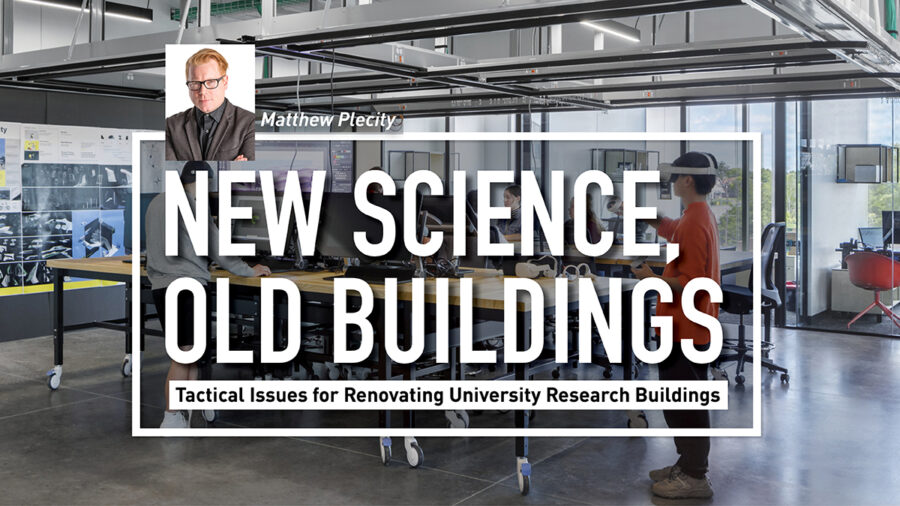Insights
Dec 7, 2023 _ insights
New Science, Old Buildings: Tactical Issues for Renovating University Research Buildings
It is an underappreciated fact that scientific work is closely connected to the built environment in which it’s done. As Henning Schmidgen of Bauhaus University puts it, “It is almost impossible to imagine science without laboratories. Our concept and image of modern science is fundamentally defined by special buildings in which experts utilize vast technical resources to investigate natural phenomena and processes.”
One easily imagines what Schmidgen calls the “iconography of the lab.” White-coated scientists sit before their microscopes, a syringe in hand. On black epoxy countertops before them sits a strangely configured assembly of vials, beakers, tubing, and Bunson burners. Glass-cased shelves hold assorted specimens in the background, and tubes carrying various gases hang from the ceiling. Workbench lights with articulated arms sit within reach, ready to shed their light on nature’s secrets.
But our cultural imagination is out of date—frozen somewhere between Mary Shelley’s Frankenstein and the early 20th Century. No doubt, test tubes, thermometers, petri dishes, and Vernier Calipers will remain critical instruments of many labs for the foreseeable future, but academic laboratories are changing.
Indeed, they have been for a long time. But with universities seeing increased demand for applied, interdisciplinary research and the influence of emerging technologies—artificial intelligence, automation, computer simulation, and intelligent laboratory instrument management systems—the rate of change is accelerating.
To Build (Anew), Or Not to Build?
This raises the question: If laboratory research is closely connected to a highly specialized, built environment, does a transformation in the way it’s conducted require us to build wholly new research buildings? And if so, what’s to become of the old?
There are certainly times when a new building is appropriate. Most existing academic research buildings don’t enjoy large, column-free spaces. In the first half of the 20th Century when many university research spaces were built, the building assemblies that were being used didn’t make it easy to create large, column-free spaces. So, if the research you’re anticipating requires vast, unbroken spaces, you may need a new building. New buildings can better manage vibration, which can be very important to research outcomes. So, sometimes a new building is the answer, but not always.
Environmental & Financial Considerations
The decision of whether to build a new research building or renovate existing spaces also needs to be weighed within a larger context. Colleges and universities should ask how sustainable a new building is. In environmental terms, there is a tradeoff between preserving the embodied carbon of older buildings and the better energy performance that can be gained with new buildings (with better envelopes). But this question of sustainability also has a financial dimension.
The fact is that many universities are overbuilt. A 2021 report from the Association of Physical Plant Administrators (APPA) estimates that higher education is facing a deferred maintenance bill of approximately $121 billion. This is due in part to the building boom in the first decades of this century, when universities invested heavily in amenities that were intended to attract students. One study states that the amount of space per student had tripled from the 1970s to 2010. This situation was exacerbated by the pandemic, which resulted in 2023 enrollment figures that were down 6% from 2019. It also promises to get worse as colleges face a “demographic cliff” in the pool of traditional, college-aged people. Beginning in 2025, there will be a 15% drop in the number of 18-year-olds in the United States. So, not only are colleges overbuilt, but much of the newer construction that has taken place on campus has focused on amenities that are serving a smaller number of students.
Against this backdrop—and with renewed federal investment in university research—there are compelling reasons for universities who are considering investing in research facilities to invest in the renovation of facilities. Not only will such an investment extend the life of the carbon already embodied in the building, but it can also chip away at a daunting deferred maintenance backlog. It may not always be the answer, but a smart renovation of an existing research building can create more efficient, productive, connected, and future-oriented research spaces.
Having established the dilemma that universities face when considering the future of their research facilities, we will be publishing a series of articles that delve into specific, tactical issues to consider when reorienting your research spaces toward the future. Topics to be discussed will include strategies for rationalizing existing lab spaces, ways of prioritizing flexibility (especially for labs with rotating research teams), and ways to reconfigure research buildings to foster connectivity and multidisciplinary collaboration.

Matthew Plecity, AIA, ASLA is a principal at GBBN. An architect with a landscape architecture background, Matt leverages his understanding of site and context to design buildings with strong relationships to their environments. As part of the leadership team for GBBN’s Higher Education Market, he regularly shares his insights into campus design, sustainability, academic libraries, and research spaces at regional, national, and international conferences. Matt loves collaborating with clients, colleagues, and consultants to build bold ideas like University of Pittsburgh’s Hillman Library renovation and Penn State Behrend’s Federal House.




